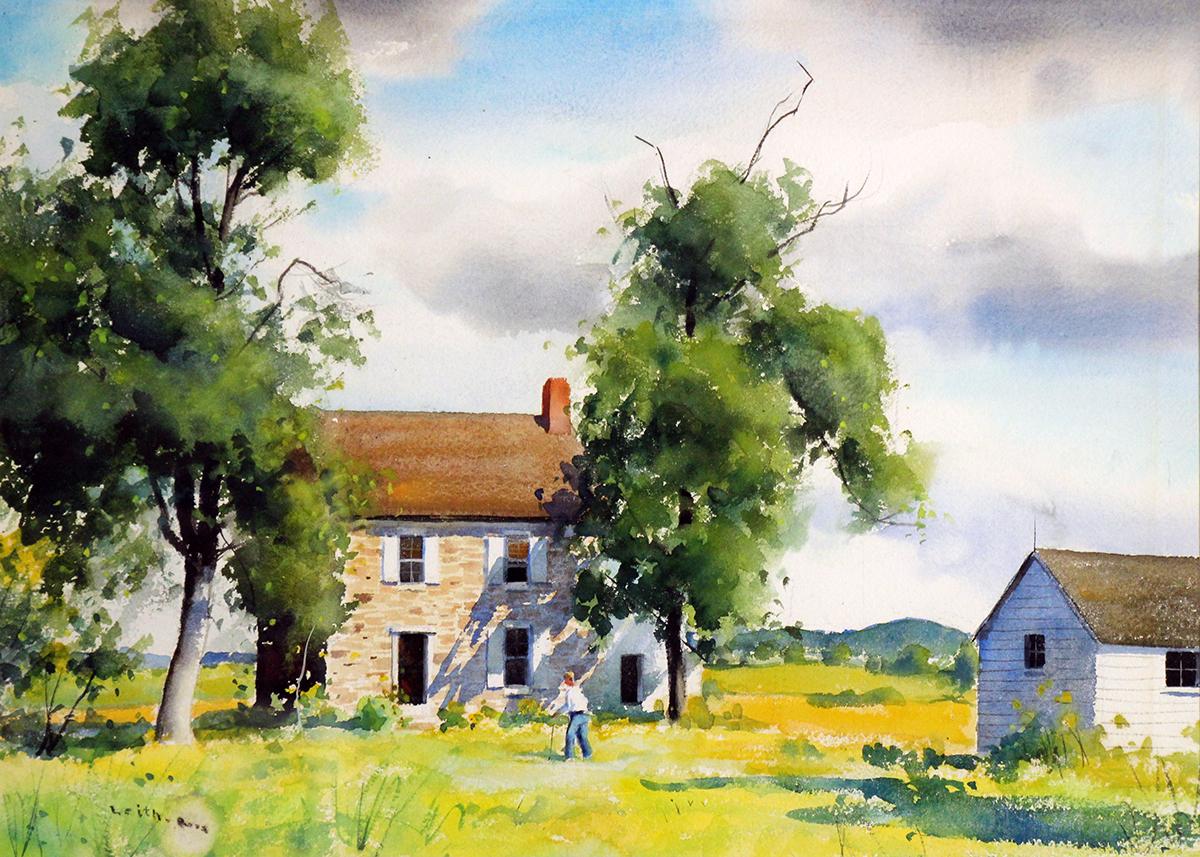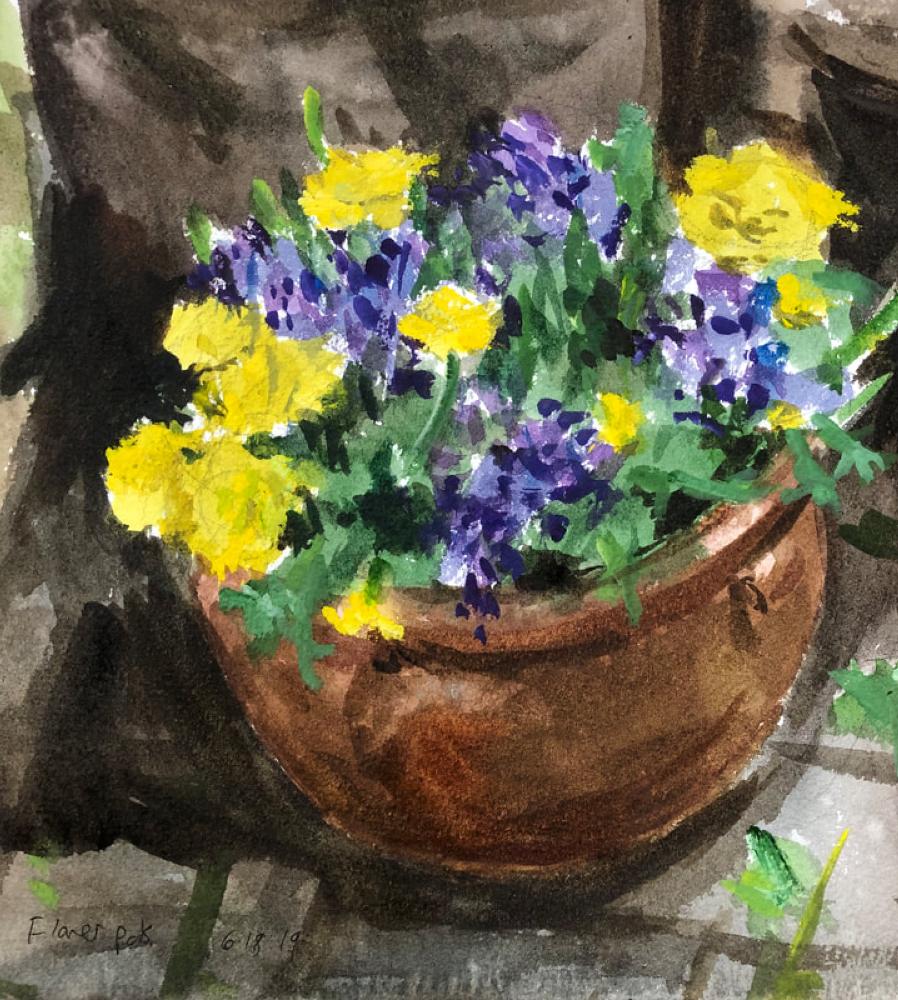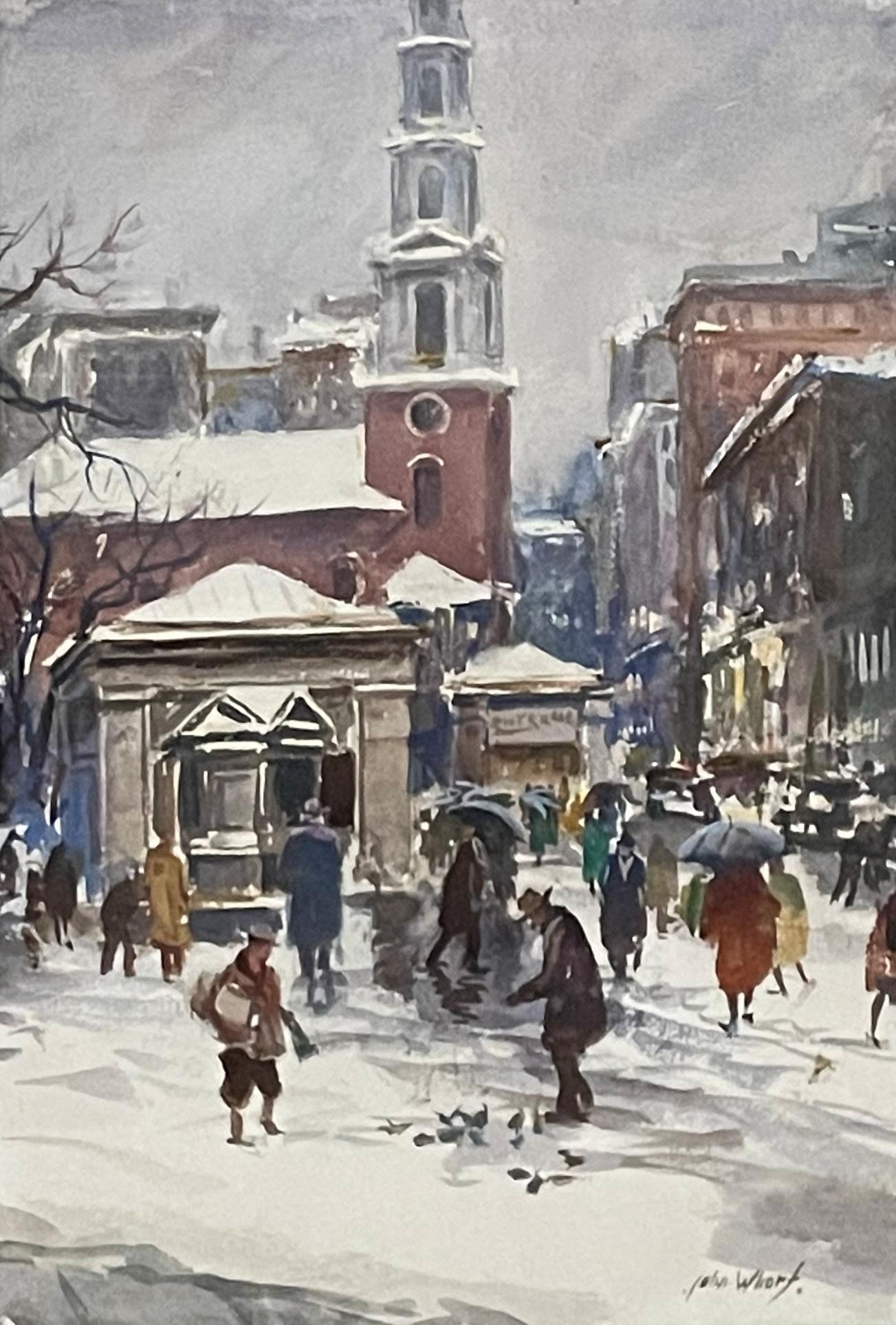Items Similar to Alameda River Below Mt. Tamalpais - Early 20th Century Landscape
Want more images or videos?
Request additional images or videos from the seller
1 of 9
Marius SchmidtAlameda River Below Mt. Tamalpais - Early 20th Century Landscape 1909
1909
About the Item
Beautiful early 20th century landscape of the Alameda River below Mt. Tamalpais by Marius Schmidt (American, 1863-1938). Presented in a giltwood frame. Signed "Marius Schmit" lower left. Image size, 14"H x 20"W.
Marius Schmidt was a resident of Oakland, California between 1909 and 1917.
Born Kolding, Denmark 1868, Marius Schmidt showed a natural affinity for art from his mother's family, and by the age of four was drawing with a natural facility. His father discouraged his artistic talents and when Marius was 12, his father sent him to live in the United States. His uncle appreciated and encouraged his ability and later sent him to Denmark to study under Jorgensen of Copenhagen and Moller, with whom he studied three years.
Upon returning to America, he settled in California where he painted "for many years the wildflowers and scenery of Northern and Southern California; the redwoods, desert, and many of our beautiful missions and gardens throughout the state. . . . Among his most famous and noted paintings are 'Capistrano Mission and Gardens' and 'Ramona's Marriage Place.' "
There are three distinct styles or periods of work. The first is 19th century European Realism; the Second is Impressionism. The third style is California Impressionism, where he adopts a more commercial style.
Paintings in the categories of the first two styles are signed Marius Schmidt, but after 1917, he moved to Southern California where his work is signed Marius Smith, a name change due to anti-German sentiment during World War 1.
Marius Schmidt was known to have lived and painted in the Laguna Beach area and passed away in 1938. Marius Schmidt was a resident of Oakland, California between 1909 and 1917. In both watercolor and oil, he painted coastal views, landscapes, and San Francisco bay area scenes. He exhibited at the San Francisco Art Association. (Edan Hughes, author of the book "Artists in California, 1786-1940", Crocker Museum)
- Creator:Marius Schmidt (1863 - 1938, American)
- Creation Year:1909
- Dimensions:Height: 16 in (40.64 cm)Width: 24 in (60.96 cm)Depth: 2 in (5.08 cm)
- Medium:
- Movement & Style:
- Period:
- Condition:Several small spots of foxing and some minor age toning to paper. Frame is rustic and of the period.
- Gallery Location:Soquel, CA
- Reference Number:
About the Seller
5.0
Platinum Seller
These expertly vetted sellers are 1stDibs' most experienced sellers and are rated highest by our customers.
Established in 1986
1stDibs seller since 2014
2,510 sales on 1stDibs
Typical response time: <1 hour
- ShippingRetrieving quote...Ships From: Soquel, CA
- Return PolicyA return for this item may be initiated within 14 days of delivery.
More From This SellerView All
- Trout Gulch Road Design Proposal, Aptos CA - Watercolor on Heavy CardstockBy Jon BlanchetteLocated in Soquel, CABeautiful mid century watercolor of a design proposal for the village Fair Antiques "Apple Barn" in Aptos, California by listed artist Jon Blanchette (American, 1908-1987). Circa 1960 Signed "Jon Blanchette" lower right. Information about location and previous owner is on verso. Acquired with a collection of the artist's work. Art size: 9"H x 12"W Jon Blanchette was born in Somerset, England on March 29, 1908. He immigrated to Battle Creek, Michigan in 1918. Artistically inclined at age six, he later studied at the Pittsburgh Art...Category
Mid-20th Century American Impressionist Landscape Paintings
MaterialsWatercolor, Postcard, Permanent Marker
- San Diego Harbor at Night - Nocturnal Coastal Scene with US Navy ShipsLocated in Soquel, CASerene nocturnal seascape by George Fotherly Hargitt (American/Scottish, 1837-1926). The San Diego harbor stretches out in front of the viewer, depicted from a vantage point above th...Category
1920s American Impressionist Landscape Paintings
MaterialsWatercolor, Laid Paper, Gouache
- Shops in Aptos Village on Soquel Drive, Aptos, California - WatercolorBy Jon BlanchetteLocated in Soquel, CABeautiful mid century watercolor of stores in Aptos, California by listed artist Jon Blanchette (American, 1908-1987). Three stores sit side-by-side: a liquor store, a general store, and a pharmacy on the Old Aptos Village Boardwalk". They are brightly colored - green, yellow, and blue. In the background, there is a blue sky, green trees, and representations of the Aptos hills. Circa 1960 Signed "Jon Blanchette" lower right. Information about location and previous owner is on verso. Acquired with a collection of the artist's work. Art size: 9"H x 12"W Jon Blanchette was born in Somerset, England on March 29, 1908. He immigrated to Battle Creek, Michigan in 1918. Artistically inclined at age six, he later studied at the Pittsburgh Art...Category
Mid-20th Century American Impressionist Landscape Paintings
MaterialsPostcard, Watercolor, Permanent Marker
- Carriage Outside the St Charles Saloon - Columbia CA - Monochrome WatercolorLocated in Soquel, CADelicate watercolor of a carriage in front of two buildings by an unknown artist (20th Century). A carriage sits in front of two buildings, with bare trees framing the scene. This pi...Category
Late 20th Century American Impressionist Landscape Paintings
MaterialsWatercolor, Archival Paper
- Fishing Boats Along The CoastLocated in Soquel, CAFishing Boats Along The Coast Watercolor painting depicting two fishing boats and fishermen along the oceanside by Robert Wayne Daley (American, 1922-1999). Rocks make up a pathway along the beach, while fishermen pull boats along the shore. Blue skies, with the ocean and hilltops making up the near distance. Signed "Robert W Daley...Category
Late 20th Century American Impressionist Figurative Drawings and Waterco...
MaterialsWatercolor, Paper
- Blue Hills LandscapeLocated in Soquel, CAGorgeous watercolor painting of a landscape depicting light blue hills with faint pink mountains in the background and vibrant green grasslands in the front....Category
1980s American Impressionist Landscape Paintings
MaterialsWatercolor, Laid Paper
You May Also Like
- Homestead, Regional American Landscape by Pennsylvania ImpressionistBy Harry Leith-RossLocated in Doylestown, PA"Homestead" is a regional, American landscape by Pennsylvania Impressionist and New Hope School painter Harry Leith-Ross. The painting is a 14" x 19" watercolor on paper, signed "Lei...Category
1940s American Impressionist Figurative Paintings
MaterialsWatercolor, Archival Paper
- Blooming Flower Pots, Watercolor and Gouache over Pencil on White Paper, FramedLocated in Houston, TXBlooming Flower Pots is a Watercolor and Gouache over Pencil on White Paper .It is framed and ready to be shipped. One artists described Santoli's paintings as "Now that is a world class oil painting! Realistic casual brush work. The best I have seen. Delicious !! " Artist Statement: I simply love painting and my goal is to capture sunlight and color so that viewers can enjoy it as well. Eric...Category
2010s American Impressionist Still-life Paintings
MaterialsPaper, Watercolor
- "Train Station, " Max Kuehne, Industrial City Scene, American ImpressionismBy Max KuehneLocated in New York, NYMax Kuehne (1880 - 1968) Train Station, circa 1910 Watercolor on paper 8 1/4 x 10 1/4 inches Signed lower right Provenance: Private Collection, Illinois Max Kuehne was born in Halle, Germany on November 7, 1880. During his adolescence the family immigrated to America and settled in Flushing, New York. As a young man, Max was active in rowing events, bicycle racing, swimming and sailing. After experimenting with various occupations, Kuehne decided to study art, which led him to William Merritt Chase's famous school in New York; he was trained by Chase himself, then by Kenneth Hayes Miller. Chase was at the peak of his career, and his portraits were especially in demand. Kuehne would have profited from Chase's invaluable lessons in technique, as well as his inspirational personality. Miller, only four years older than Kuehne, was another of the many artists to benefit from Chase's teachings. Even though Miller still would have been under the spell of Chase upon Kuehne's arrival, he was already experimenting with an aestheticism that went beyond Chase's realism and virtuosity of the brush. Later Miller developed a style dependent upon volumetric figures that recall Italian Renaissance prototypes. Kuehne moved from Miller to Robert Henri in 1909. Rockwell Kent, who also studied under Chase, Miller, and Henri, expressed what he felt were their respective contributions: "As Chase had taught us to use our eyes, and Henri to enlist our hearts, Miller called on us to use our heads." (Rockwell Kent, It's Me O Lord: The Autobiography of Rockwell Kent. New York: Dodd, Mead and Co., 1955, p. 83). Henri prompted Kuehne to search out the unvarnished realities of urban living; a notable portion of Henri's stylistic formula was incorporated into his work. Having received such a thorough foundation in art, Kuehne spent a year in Europe's major art museums to study techniques of the old masters. His son Richard named Ernest Lawson as one of Max Kuehne's European traveling companions. In 1911 Kuehne moved to New York where he maintained a studio and painted everyday scenes around him, using the rather Manet-like, dark palette of Henri. A trip to Gloucester during the following summer engendered a brighter palette. In the words of Gallatin (1924, p. 60), during that summer Kuehne "executed some of his most successful pictures, paintings full of sunlight . . . revealing the fact that he was becoming a colorist of considerable distinction." Kuehne was away in England the year of the Armory Show (1913), where he worked on powerful, painterly seascapes on the rocky shores of Cornwall. Possibly inspired by Henri - who had discovered Madrid in 1900 then took classes there in 1906, 1908 and 1912 - Kuehne visited Spain in 1914; in all, he would spend three years there, maintaining a studio in Granada. He developed his own impressionism and a greater simplicity while in Spain, under the influence of the brilliant Mediterranean light. George Bellows convinced Kuehne to spend the summer of 1919 in Rockport, Maine (near Camden). The influence of Bellows was more than casual; he would have intensified Kuehne's commitment to paint life "in the raw" around him. After another brief trip to Spain in 1920, Kuehne went to the other Rockport (Cape Ann, Massachusetts) where he was accepted as a member of the vigorous art colony, spearheaded by Aldro T. Hibbard. Rockport's picturesque ambiance fulfilled the needs of an artist-sailor: as a writer in the Gloucester Daily Times explained, "Max Kuehne came to Rockport to paint, but he stayed to sail." The 1920s was a boom decade for Cape Ann, as it was for the rest of the nation. Kuehne's studio in Rockport was formerly occupied by Jonas Lie. Kuehne spent the summer of 1923 in Paris, where in July, André Breton started a brawl as the curtain went up on a play by his rival Tristan Tzara; the event signified the demise of the Dada movement. Kuehne could not relate to this avant-garde art but was apparently influenced by more traditional painters — the Fauves, Nabis, and painters such as Bonnard. Gallatin perceived a looser handling and more brilliant color in the pictures Kuehne brought back to the States in the fall. In 1926, Kuehne won the First Honorable Mention at the Carnegie Institute, and he re-exhibited there, for example, in 1937 (Before the Wind). Besides painting, Kuehne did sculpture, decorative screens, and furniture work with carved and gilded molding. In addition, he designed and carved his own frames, and John Taylor Adams encouraged Kuehne to execute etchings. Through his talents in all these media he was able to survive the Depression, and during the 1940s and 1950s these activities almost eclipsed his easel painting. In later years, Kuehne's landscapes and still-lifes show the influence of Cézanne and Bonnard, and his style changed radically. Max Kuehne died in 1968. He exhibited his work at the National Academy of Design, the Art Institute of Chicago, the Carnegie Institute in Pittsburgh, the Memorial Art Gallery of the University of Rochester, and in various New York City galleries. Kuehne's works are in the following public collections: the Detroit Institute of Arts (Marine Headland), the Whitney Museum (Diamond Hill...Category
1910s American Impressionist Landscape Drawings and Watercolors
MaterialsPaper, Watercolor
- Canal at Indian Mound RoadBy Ben FenskeLocated in Sag Harbor, NYPainted during the 2015 Winter Equestrian Festival in Wellington, Florida. A black and white depiction of a canal, is barely recognizable, due to Fenske's wild brushstrokes and lack...Category
21st Century and Contemporary American Impressionist Landscape Paintings
MaterialsGouache, Paper
- Study for Skunk Cabbage, Watercolor Painting by Charles Burchfield 1931By Charles E. BurchfieldLocated in Long Island City, NYA watercolor painting by Charles Burchfield from 1931. A still life botanical painting of a skunk cabbage in natural setting. Signed and dated in lower right, beautifully matted and framed in gold ornate frame. The painting has an excellent provenance through top New York Galleries including DC Moore...Category
1930s American Impressionist Landscape Paintings
MaterialsPaper, Watercolor
- Old MartinezBy Henry Waltermar DoaneLocated in San Francisco, CAArtist: Henry Waltermar Doane – American (1905-2002) Title: Old Martinez Year: circa 1970 Medium: watercolor on watercolor paper Sight size: 20 x 28 inches. Sheet size: 22 x 30 inch...Category
1960s American Impressionist Landscape Paintings
MaterialsPaper, Watercolor
Recently Viewed
View AllMore Ways To Browse
World War 1
German Early 20th Century Painting
Early 20th Century California Artists
Northern California Landscapes
San Francisco Early 20th Century
20th Century Impressionism Paintings
California Desert Landscape Paintings
19th Century Landscape With River
German River
California River
19th Century Landscape Paintings With River
European Early 20th Century Oil Painting
Early 19th Century European Paintings
River Book
19th Century European Landscape Paintings
Northern California Landscape Painting
19th Century San Francisco
20th Century American Realism




